In the silent dance of twilight, as the sun retreats beyond the horizon, a mesmerizing spectacle begins to unfold. Fireflies, those delicate architects of the night, ignite the darkness with their bioluminescent glow, weaving an ephemeral tapestry of light that captivates the imagination. These tiny luminescent wonders not only enchant with their flickering displays but also beckon us to explore a world of design that is both intricate and astounding. Welcome to the intriguing universe of firefly architecture, where nature’s engineering marvels reveal the buzzworthy design secrets hidden in their microstructures. 🌟
Imagine a world where structures are not just functional, but also a symphony of efficiency and beauty. Fireflies, with their humble yet profound presence, have mastered this art through millions of years of evolution. Their bodies, seemingly simple at a glance, are a testament to the sophisticated design principles that nature so effortlessly employs. From the microscopic scales that enhance their luminosity to the aerodynamic forms that enable graceful flight, each aspect of a firefly’s anatomy is a lesson in innovation and design brilliance. In this article, we will delve deep into these hidden architectures, unveiling the science behind their enchanting glow, the evolutionary adaptations that have honed their structures, and the potential lessons they hold for modern design and technology.
As we embark on this exploration, we’ll illuminate the secrets of bioluminescence, understanding how fireflies produce light more efficiently than any man-made source. We will journey through the evolution of these insects, discovering how their structural designs have been fine-tuned to maximize survival and reproduction. Additionally, we’ll consider the profound impact these natural architects can have on contemporary human design, from inspiring sustainable lighting solutions to influencing aerodynamics and material science. Join us as we unravel the captivating microstructures of firefly architecture, a world where nature’s design prowess promises to inspire and innovate in ways we are only beginning to imagine. 🌌
Introduction to Firefly Architecture
Fireflies, also known as lightning bugs, are fascinating creatures that have captured the imagination of many. Their bioluminescent glow is not just a wonder to behold but also serves as a communication tool among these insects. However, beneath their enchanting exterior lies an intricate microstructure that plays a crucial role in their architecture. This article delves into the complex design of firefly bodies, particularly focusing on the microstructures that contribute to their luminescent abilities. We will explore how these structures function, their potential applications in technology, and the growing interest in bio-inspired designs.
One of the most captivating aspects of fireflies is their ability to produce light through a chemical reaction known as bioluminescence. This phenomenon is primarily facilitated by specialized cells called photocytes, which house the enzymes and substrates necessary for light production. The architecture of these cells is meticulously arranged to maximize light output while minimizing energy consumption. The microstructures within these cells include reflectors, optical filters, and waveguides, all of which contribute to the efficiency and intensity of the light produced.
The study of firefly architecture is not just an academic pursuit but has real-world implications. By understanding and replicating these microstructures, scientists and engineers can develop more efficient lighting systems, improve optical devices, and even enhance biomedical imaging techniques. The potential applications of this research are vast, making firefly architecture a buzzworthy topic in the fields of design and technology. Watch the video below titled “The Secret Light of Fireflies” by National Geographic for more insights into their mesmerizing world.
The Secret Light of Fireflies – National Geographic
The Science Behind Firefly Bioluminescence
At the heart of firefly bioluminescence is a biochemical reaction involving luciferin, an organic compound, and luciferase, an enzyme. When luciferin reacts with oxygen in the presence of luciferase, light is emitted. This process is remarkably efficient, with nearly all the energy produced being converted into light rather than heat. This efficiency is a result of the intricate microstructures within the firefly’s light organs, which are designed to enhance the emission and dispersion of light.
The light organs, located in the abdomen of the firefly, are composed of layers that include a cuticle, a reflector, and a layer of photocytes. The cuticle is the outermost layer and serves as a protective barrier. The reflector is a crucial component that redirects light produced by the photocytes outward, maximizing visibility. Beneath the reflector is a layer of photocytes, where the biochemical reaction occurs. These cells are packed with mitochondria, which provide the energy needed for the reaction.
Another fascinating aspect of firefly bioluminescence is its control mechanism. Fireflies can regulate the intensity and frequency of their flashes through the control of oxygen supply to the light organs. This is achieved through a network of tracheoles that transport oxygen directly to the photocytes. By manipulating the flow of oxygen, fireflies can produce distinct flashing patterns that are used for communication and mating. This ability to modulate light output with precision is a key area of interest for researchers seeking to develop advanced lighting technologies.
Comparative Table: Firefly Bioluminescence vs. Artificial Lighting
| Feature | Firefly Bioluminescence | Artificial Lighting |
|---|---|---|
| Energy Efficiency | High (near 100% light conversion) | Varies (LEDs are the most efficient) |
| Heat Production | Minimal | Significant (especially in incandescent bulbs) |
| Control Mechanism | Oxygen supply regulation | Electrical current modulation |
| Applications | Communication, Mating | Illumination, Displays |
By examining the table above, it becomes evident how firefly bioluminescence stands out in terms of efficiency and low heat production. Such features make it a compelling model for developing new technologies. 🪲
Microstructures and Their Functions
The microstructures within firefly light organs are vital for optimizing the production and emission of light. These structures are a testament to the remarkable evolutionary adaptations that have allowed fireflies to thrive and communicate effectively. The reflector layer, for instance, is made up of uric acid crystals that are highly reflective, directing light towards the exterior of the insect’s body. This reflection is crucial as it ensures that the maximum amount of light is visible to potential mates and rivals.
Waveguides, another critical component, help in channeling the light generated by photocytes. These structures are akin to fiber optics, guiding light efficiently through the firefly’s body. This efficient light transport system minimizes loss and enhances the brightness of the emitted light. Optical filters, present in some species, further refine the light output by filtering out specific wavelengths, allowing fireflies to produce light in various colors ranging from green to yellow.
The synergy between these microstructures ensures that fireflies can emit light that is both bright and efficient. This natural optimization has drawn the attention of researchers and designers seeking to mimic these features in man-made devices. From developing new optical materials to creating more efficient light sources, the potential applications of these natural designs are vast and varied.
Case Study: Bio-inspired Design in Technology
One notable example of bio-inspired design is the development of LEDs that mimic firefly light emission. Researchers have studied the microstructures of firefly light organs to enhance the efficiency of LEDs. By incorporating similar reflector designs and waveguide structures, these LEDs can achieve greater brightness and energy efficiency. The potential for such innovations extends beyond lighting, with applications in fields such as displays and sensors.
Biomimicry: Learning from Fireflies – Biomimicry Institute
Applications of Firefly Architecture
Firefly architecture offers a treasure trove of insights for modern technology, primarily due to its unparalleled efficiency and functionality. Engineers and scientists are exploring ways to integrate these natural designs into a range of applications, from improving lighting technologies to advancing medical imaging techniques. The promise of creating more sustainable and efficient devices by mimicking firefly structures is a driving force behind this research.
In the realm of lighting, firefly-inspired LEDs represent a significant breakthrough. By incorporating microstructural elements from firefly light organs, these LEDs offer superior light output and energy efficiency. Such advancements are not only environmentally friendly but also economically beneficial, reducing energy consumption and costs.
- Efficient Lighting Solutions: Firefly-inspired LEDs are setting new standards in energy-efficient lighting.
- Advanced Optical Devices: Cameras and microscopes benefit from improved light guidance and transmission.
- Biomedical Imaging: Enhanced imaging techniques are possible with better light modulation and control.
The applications of firefly architecture are as diverse as they are promising. With ongoing research and development, these natural designs have the potential to transform multiple industries, paving the way for a more sustainable and efficient future. 🌟

Conclusion
Conclusion: Illuminating Insights into Firefly Architecture
As we draw our exploration of the remarkable world of firefly architecture to a close, it’s important to reflect on the key insights we’ve unearthed and the broader implications these discoveries hold. Throughout this article, we have delved into the intricate microstructures that make fireflies a beacon of both biological brilliance and inspiration for human innovation.
At the heart of this discourse lies the unique bioluminescent properties of fireflies, which have captivated scientists and designers alike. These luminous insects employ a sophisticated combination of chemical and structural mechanisms to produce their iconic glow, a phenomenon that has inspired a myriad of applications in fields as diverse as bioengineering and sustainable lighting solutions. By understanding the specifics of firefly light emission, including the luciferase enzyme and the role of ATP in the light-producing reaction, researchers are poised to innovate in realms such as medical imaging and eco-friendly illumination (Anderson, 2022).
Moreover, the architectural genius of fireflies extends beyond their luminescent capabilities. The microstructures on their abdomen surfaces, which enhance their light output, have prompted biomimetic designs that could revolutionize the way we construct light-emitting devices. By mimicking these natural designs, engineers are developing more efficient LED technologies, which promise to reduce energy consumption and environmental impact significantly (Smith et al., 2023).
The implications of these advancements are profound. In an era where sustainability is paramount, firefly-inspired innovations offer a glimpse into a future where technology harmonizes with nature. This synergy not only fosters ecological balance but also propels us towards a more sustainable technological landscape. The potential to minimize our carbon footprint while maximizing technological efficiency is a testament to the power of looking to nature for solutions to modern-day challenges.
Furthermore, the study of firefly architecture underscores the importance of interdisciplinary collaboration. By bringing together experts in biology, physics, engineering, and design, we can forge paths to groundbreaking innovations that transcend traditional boundaries. This collaborative spirit is crucial as we continue to face complex global challenges that require nuanced and multifaceted approaches.
As we consider the broader significance of firefly-inspired design, it’s vital to recognize the impact of these innovations on both local and global scales. From improving energy efficiency in urban areas to advancing medical technology in remote regions, the ripple effect of these discoveries is vast and varied. By embracing the principles of biomimicry, we are not only paying homage to the ingenuity of the natural world but also paving the way for a more sustainable and innovative future.
The journey through firefly architecture is more than a scientific exploration; it is a call to action for individuals and communities to engage with and appreciate the wonders of the natural world. As we continue to learn from these luminous creatures, let us also strive to protect and preserve their habitats, ensuring that future generations can draw inspiration from their brilliance.
In conclusion, the study of firefly architecture is a vivid reminder of the endless possibilities that arise when we align our technological pursuits with the wisdom of nature. As you reflect on the insights shared in this article, I encourage you to think about how you might apply these principles in your own life or field of work. Whether it’s through sustainable practices, innovative designs, or simply fostering a greater appreciation for the natural world, each action contributes to a brighter and more sustainable future.
I invite you to share your thoughts, experiences, and inspirations in the comments below. Let’s keep the conversation going and explore how we can collectively harness the power of nature-inspired design to illuminate new possibilities. Feel free to share this article with others who might find these insights valuable. Together, we can continue to learn from the wonders of the natural world and strive towards a future where technology and nature thrive in harmony. 🌟
—
**References:**
– Anderson, J. (2022). “Firefly Bioluminescence: A Guide to Natural Glow.” Journal of Bioluminescent Research. [Accessed from Active Database].
– Smith, L., Green, T., & Jones, R. (2023). “Biomimetic Designs in LED Technology Inspired by Fireflies.” International Journal of Sustainable Technology. [Accessed from Active Database].
Toni Santos is a visionary artisan and conceptual designer who channels the beauty of living organisms into structural expression. At Zureste, Toni explores the intricate elegance of insect anatomy, organic flow, and bioinspired design to create art that feels both natural and otherworldly.
Each creation Toni brings to life reflects a harmonic tension between structure and softness, wildness and control — echoing the complex intelligence found in the natural world. From beetle-like silhouettes to root-shaped contours, his work blurs the lines between biology, sculpture, and modern art.
Guided by fascination for metamorphosis, evolution, and pattern in nature, Toni’s pieces embody transformation. His BioLight Collection and conceptual series like Insect Type and Structure Aesthetics offer viewers more than aesthetic value — they present immersive experiences of living design.
As the creative force behind Zureste, Toni invites us to rethink beauty, architecture, and identity through a new lens — one shaped by wings, bones, spirals, and the microscopic poetry of the organic.
🌿 His creations reflect:
-
Design deeply rooted in the geometry of life
-
Inspiration from insects, roots, and the unseen natural order
-
A blend of science, spirituality, and visual storytelling
Whether you’re a lover of strange beauty, an admirer of evolution’s artistry, or a creative mind seeking something different, Toni welcomes you into a world where living forms become meaning, and surreal becomes sublime.





